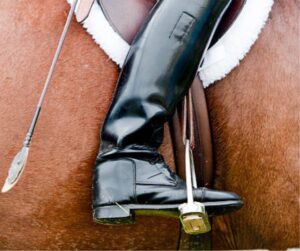Anettte Wilson | 0447337276
Anettte Wilson | 0447337276

I believe the lower leg is the most important body part to train for stability, control, and strength in horse riding. I see and hear from many other instructors the training of the seat is the first priority. Well, I am confident to challenge this concept and train my pupils with a different process.
When the rider’s lower leg is too far forward and not solid against the horse’s side the hamstring muscle is not engaged. When the Hamstring muscle is active the knee will remain bent and control the position of the lower leg. By over-pushing through the quads while deactivating the hamstrings the lower leg either swings forward or away from the horse’s side. This is most obvious at the trot.

Both the rising trot and the sitting trot create a movement that the rider cannot control. Control of the lower leg can be gained if the rider is taught how to use the lower leg properly. The hamstrings are the key muscle to control the lower leg movement and stability.
I know this because I am a Physiotherapist and I teach Rider Biomechanics. The lower leg can sit solidly against the horse without putting pressure on the horse. This is another skill to learn for horse riding. Once a rider can keep the leg still the seat is the next target to train.
The deep independent seat is the aim and end result of our rider training but the end result needs to follow certain steps before it can be achieved. Horse riding is so different from other sports because we are trying to balance, control, and direct a live animal with its own personality.
Horse riding exercise programs need to acknowledge this. A hockey stick or a basketball will go where you direct it. A horse does not always comply. In addition, they decide to spook at imaginary things, spontaneously.
Good balance makes for a safe confident rider and a strong stable lower leg will provide a rider with good balance and strength to support their seat body and hands. Once the seat becomes dislodged a rider will always grab the reins. The seat is less likely to become dislodged at spontaneous movements if the lower leg is solid.

Once the lower leg is solid and the use of the hamstrings and quads is coordinated then a rider can move on to train the pelvis, and lower back, and train for a deep independent seat. The seat is only independent if the lower legs, trunk, and hands can move and be used without the seat bouncing in and out of the saddle. I call these horse riding exercises…. movement patterns.. and these patterns are unique to my program.
A movement pattern is a practiced part of a whole movement. For example, if we want to learn to walk again after a major injury the physio will break up the routine. So back to the horse rider. The hamstrings bend the knee if the hip is fixed the heel will move closer to the butt. If the heel is fixed and the hamstrings tighten the hip will move closer to the horse. This movement is the aid to apply the lower leg and engage the seat into a deeper position. This is a difficult concept to write about and for riders to understand.
My Applied Posture Riding Membership Program has much more detail than I can write here. The Quads straighten the knee and we all know this. If we are sitting in a chair and we decide to stand up, we transfer our weight from our seat to our feet, by extending our hips, and knees to straighten up. Because the ground is fixed our heels and feet stay still. Our body moves over our feet and then straightens up. There are quite a few changes in the center of gravity to get upright.
When we stand up in the stirrups our weight transfers from our seat to our stirrups, as in the rising trot. Because the stirrups are not fixed the weight transfer will cause the stirrup to move and in every case, the lower leg will swing away from the horse’s side. To stop this when we are rising trot we need to learn a movement pattern to train the lower leg to stay at the horse’s side.
Training the hamstrings to bend the knee is one of the most important movement

patterns in dressage riding. It is not the calf muscle! When the horse rider is sitting deep and upright and wants to apply an aid it is the hamstring muscle that comes into play. The adductor muscles will support as a clamp or an anchor and the seat will follow. It is not the seat then the legs…It may well feel like it but if the lower leg is not engaged first the seat has nothing to stabilize on. Every force needs an anchor point.
Very good riders do all this in a split second and appear to be doing nothing. The learner rider needs to train the individual movement patterns to be able to achieve the end result. There is a simple exercise you can do immediately on a gym ball.
If you want more information on this or just want some advice go to my Applied Posture Riding Membership Program.
So If you get a wobble up in your lower leg when trotting or at the canter then this means the use of your lower leg muscles when riding is not correct.
Enjoy your riding and good luck
Annette Willson.
Remember to look at yourself before you blame the horse.
Look Good Ride Well Dismiss